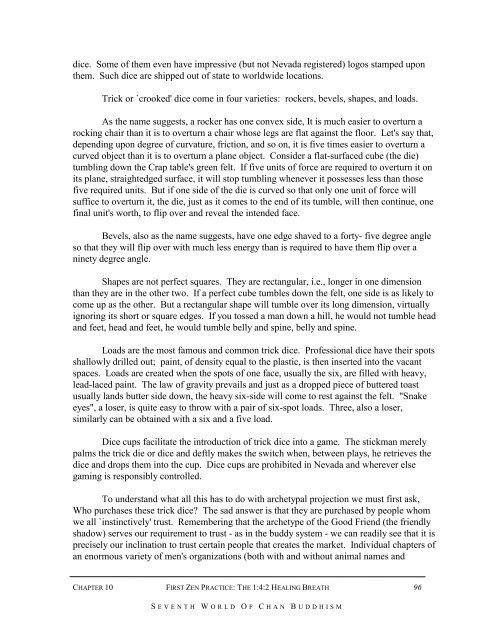seventh world of chan buddhism - Zen Buddhist Order of Hsu Yun
seventh world of chan buddhism - Zen Buddhist Order of Hsu Yun
seventh world of chan buddhism - Zen Buddhist Order of Hsu Yun
You also want an ePaper? Increase the reach of your titles
YUMPU automatically turns print PDFs into web optimized ePapers that Google loves.
dice. Some <strong>of</strong> them even have impressive (but not Nevada registered) logos stamped upon<br />
them. Such dice are shipped out <strong>of</strong> state to <strong>world</strong>wide locations.<br />
Trick or `crooked' dice come in four varieties: rockers, bevels, shapes, and loads.<br />
As the name suggests, a rocker has one convex side, It is much easier to overturn a<br />
rocking chair than it is to overturn a chair whose legs are flat against the floor. Let's say that,<br />
depending upon degree <strong>of</strong> curvature, friction, and so on, it is five times easier to overturn a<br />
curved object than it is to overturn a plane object. Consider a flat-surfaced cube (the die)<br />
tumbling down the Crap table's green felt. If five units <strong>of</strong> force are required to overturn it on<br />
its plane, straightedged surface, it will stop tumbling whenever it possesses less than those<br />
five required units. But if one side <strong>of</strong> the die is curved so that only one unit <strong>of</strong> force will<br />
suffice to overturn it, the die, just as it comes to the end <strong>of</strong> its tumble, will then continue, one<br />
final unit's worth, to flip over and reveal the intended face.<br />
Bevels, also as the name suggests, have one edge shaved to a forty- five degree angle<br />
so that they will flip over with much less energy than is required to have them flip over a<br />
ninety degree angle.<br />
Shapes are not perfect squares. They are rectangular, i.e., longer in one dimension<br />
than they are in the other two. If a perfect cube tumbles down the felt, one side is as likely to<br />
come up as the other. But a rectangular shape will tumble over its long dimension, virtually<br />
ignoring its short or square edges. If you tossed a man down a hill, he would not tumble head<br />
and feet, head and feet, he would tumble belly and spine, belly and spine.<br />
Loads are the most famous and common trick dice. Pr<strong>of</strong>essional dice have their spots<br />
shallowly drilled out; paint, <strong>of</strong> density equal to the plastic, is then inserted into the vacant<br />
spaces. Loads are created when the spots <strong>of</strong> one face, usually the six, are filled with heavy,<br />
lead-laced paint. The law <strong>of</strong> gravity prevails and just as a dropped piece <strong>of</strong> buttered toast<br />
usually lands butter side down, the heavy six-side will come to rest against the felt. "Snake<br />
eyes", a loser, is quite easy to throw with a pair <strong>of</strong> six-spot loads. Three, also a loser,<br />
similarly can be obtained with a six and a five load.<br />
Dice cups facilitate the introduction <strong>of</strong> trick dice into a game. The stickman merely<br />
palms the trick die or dice and deftly makes the switch when, between plays, he retrieves the<br />
dice and drops them into the cup. Dice cups are prohibited in Nevada and wherever else<br />
gaming is responsibly controlled.<br />
To understand what all this has to do with archetypal projection we must first ask,<br />
Who purchases these trick dice? The sad answer is that they are purchased by people whom<br />
we all `instinctively' trust. Remembering that the archetype <strong>of</strong> the Good Friend (the friendly<br />
shadow) serves our requirement to trust - as in the buddy system - we can readily see that it is<br />
precisely our inclination to trust certain people that creates the market. Individual chapters <strong>of</strong><br />
an enormous variety <strong>of</strong> men's organizations (both with and without animal names and<br />
CHAPTER 10 FIRST ZEN PRACTICE: THE 1:4:2 HEALING BREATH<br />
S EVENTH W ORLD O F C HAN B UDDHISM<br />
96


